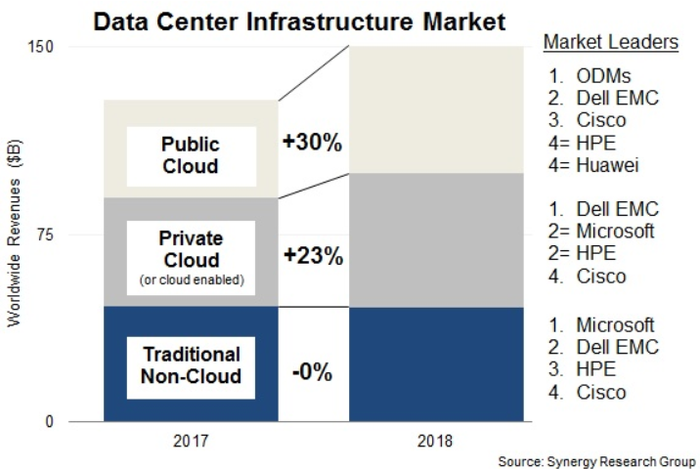Spending on AWS, Google, Microsoft Azure Public Clouds SoarsSpending on AWS, Google, Microsoft Azure Public Clouds Soars
New reports show the rippling impacts enterprise migration to the cloud is having on IT.
April 5, 2019

The impacts of the migration of enterprises and other organizations into the cloud continues to ripple through the IT industry, with two reports reiterating the how central the compute model has become to enterprises’ strategies.
Gartner analysts said this week that the global public cloud services market will grow 17.5 percent this year, reaching $214.3 billion in 2019. Last year it was $182.4 billion.
At the same time, analysts with Synergy Research Group highlighted how the top public cloud vendors, such as Amazon Web Services (AWS), Microsoft Azure and Google Cloud Platform, are increasingly becoming key drivers behind data-center hardware and software spending.
 Worldwide, such spending in 2018 increased 17 percent, with public cloud services and the need for richer server configurations – due to increasingly complex workloads and the push toward private clouds – being among the factors fueling the spending growth. The spending on public-cloud infrastructure jumped 30 percent over 2017, the analysts said.
Worldwide, such spending in 2018 increased 17 percent, with public cloud services and the need for richer server configurations – due to increasingly complex workloads and the push toward private clouds – being among the factors fueling the spending growth. The spending on public-cloud infrastructure jumped 30 percent over 2017, the analysts said.
Both reports are additional proof points that more data and workloads – and the changing nature of workloads that are increasingly leveraging such tasks as artificial intelligence (AI), machine learning, analytics and virtual and augmented reality – are moving into the cloud to help increase efficiencies, reduce costs and improve operations.
“Cloud service revenues continue to grow by almost 50 percent per year, enterprise SaaS [software-as-a-service] revenues are growing by 30 percent, search/social networking revenues are growing by almost 25 percent, and e-commerce revenues are growing by over 30 percent, all of which are helping to drive big increases in spending on public cloud infrastructure,” said John Dinsdale, chief analyst at Synergy Research.
The numbers from Gartner and Synergy Research reinforce what analyst firms, vendors and channel partners have been seeing for the past several years. Most recently, IDC analysts in February projected that spending on public cloud services and infrastructure this year will hit $210 billion – a 23.8 percent over 2018 – and will reach $370 billion in 2022.
Eilleen Smith, program director of IDC’s customer insights and analysis group, said at the time that while most organizations have embraced the public cloud “as a cost-effective platform for hosting enterprise applications and for developing and deploying customer-facing solutions. Over the next five years … cloud platforms and ecosystems will serve as the launch pad for an explosion in the scale and pace of digital innovation. The result will be ‘multiplied innovation’ with as many new applications deployed in the cloud as prior generations deployed over the previous four decades.”
Multiple recent studies have shown that many enterprises are not only adopting the public cloud, but pursuing multicloud strategies that call for using more than one public cloud provider. Network analytics vendor Kentik in January said 58 percent of survey respondents claimed to use more than one provider, with 18 percent saying they were using AWS, Azure and Google Cloud. In its own study, Flexera found that 84 percent of companies have multicloud strategies.

Gartner’s Sid Nag
Such survey results help explain the spending numbers that Gartner, Synergy Research and others are finding.
“Cloud services are definitely shaking up the industry,” said Sid Nag, research vice president at Gartner. “We know of no vendor or service provider today whose business-model offerings and revenue growth are not influenced by the increasing adoption of cloud-first strategies of organizations.”
That trend will only continue, Nag said, adding that the market for cloud services will see …
… three times the growth of the overall IT services space by 2022. Gartner surveys found that more than one-third of organizations say cloud investments are a top-three investing priority and that by the end of 2019, more than 30 percent of technology providers’ new software investments will move from cloud-first to cloud-only.
All of this is forcing shifts within the industry. Gartner analysts noted that the move from cloud-first to cloud-only will mean that traditional license-based software consumption will continue to contract, giving way to SaaS and subscription-based cloud consumption models.
Such trends can be seen on the hardware side. Spending on public cloud infrastructure jumped 30 percent in 2018 while enterprise data-center infrastructure spending increased 13 percent, Synergy Research found. Much of that, however was fueled by the 23 percent growing private cloud or cloud-enabled infrastructure, while there was a marginal decline in traditional non-cloud infrastructure.
The growth in public cloud infrastructure spending also continues to help improve the fortunes of original-design manufacturers (ODMs) that build low-cost systems and have become larger players in the global server and networking spaces. As a group, ODMs were the top infrastructure suppliers to the public cloud providers followed by Dell EMC, Cisco, Hewlett Packard Enterprise and Huawei.
Dell EMC was the number-one supplier for private clouds, while Microsoft was the top vendor for traditional non-cloud environments.
In addition, the shift to the public cloud and the requirements for richer configurations also is driving up average selling prices (ASPs).
“We are also now seeing some reasonably strong growth in enterprise data-center infrastructure spending, with the main catalysts being more complex workloads, hybrid cloud requirements, increased server functionality and higher component costs,” Synergy’s Dinsdale said. “We are not seeing much unit volume growth in enterprise, but vendors are benefitting from substantially higher ASPs.”
Read more about:
Channel ResearchAbout the Author
You May Also Like


